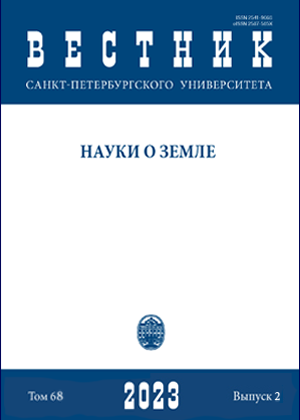Геохимия голоцен-позднеплейстоценовых отложений в долине р. Березовка (Приенисейская Сибирь)
DOI:
https://doi.org/10.21638/spbu07.2023.206Аннотация
Несмотря на огромную значимость, голоцен-поздне-плейстоценовые отложения слабо изучены в долинах рек на территории Красноярской лесостепи. В статье приведены первые детальные исследования геохимического состава отложений первой надпойменной террасы в долине р.Березовка, непрерывное накопление которых происходило в поздне-плейстоцен-голоценовое время (начиная с 20833 ± 519 кал. лет назад), что имеет важное фундаментальное значение и является основой для дальнейших исследований природной среды при антропогенном влиянии в условиях Красноярской агломерации. Отложения перекрыты современной аллювиальной темногумусовой гидрометаморфизованной почвой. Макроморфологические исследования и исследование содержания гумуса выявили наличие хорошо развитых процессов гумусообразования и гумусонакопления, глеевого процесса. Установлено превышение кларков земной коры для нескольких элементов (U, Pr, Rb, V, Bi, Cd, As, Th, Ga, Co, Sm). Распределение большинства элементов и их накопление в среднем-позднем голоцене (от 5477-4985 до 1241-803 кал. лет назад) в средней части профиля объясняется высоким содержанием ила и глинистых минералов. На основании расчетов коэффициентов радиальной миграции установлено, что большинство исследованных элементов накапливались во время паводков и половодий. Полученные новые данные геохимических исследований на территории Красноярской лесостепи будут основой для сравнения спонтанных и антропогенных изменений состояния природной среды. Значения палеомаркеров свидетельствуют об изменении климатических условий в позднем плейстоцене от сухих и холодных к более влажным и теплым; в голоцене – от аридных и холодных (в раннем голоцене) к современным.
Ключевые слова:
Геохимия отложений, радиоуглеродное датирование, голоцен, первая терраса р. Березовка, аллювиальные почвы, Красноярская лесостепь, бассейн реки Енисей
Скачивания
Библиографические ссылки
Загрузки
Опубликован
Как цитировать
Выпуск
Раздел
Лицензия
Статьи журнала «Вестник Санкт-Петербургского университета. Науки о Земле» находятся в открытом доступе и распространяются в соответствии с условиями Лицензионного Договора с Санкт-Петербургским государственным университетом, который бесплатно предоставляет авторам неограниченное распространение и самостоятельное архивирование.






